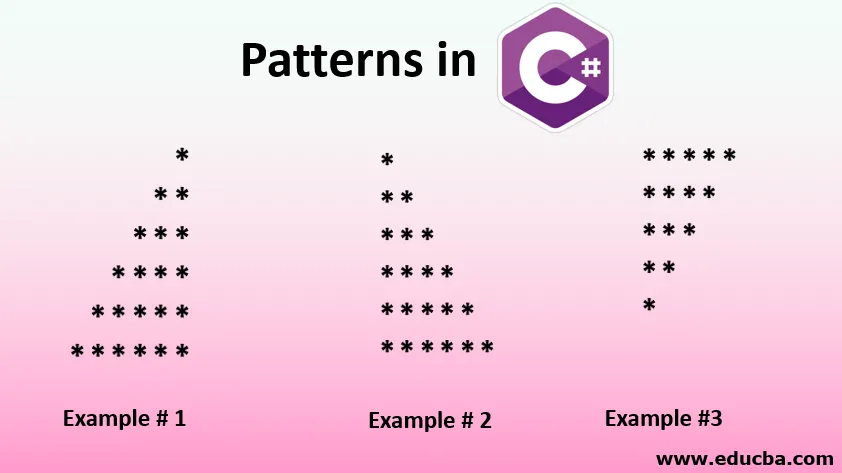
Introduction aux modèles en C #
Les motifs sont la conception décorative répétée. Il existe un code simple pour écrire des modèles en C #. Nous pouvons écrire du code pour imprimer différents types de motifs comme le motif en étoile, le motif de caractère et le motif numérique. Vous trouverez ci-dessous les différents exemples d'impression de motifs d'étoiles, de caractères et de valeurs numériques. Ces exemples sont constitués de boucles ou de boucles imbriquées qui est une boucle à l'intérieur d'une boucle. Les motifs sont une façon de concevoir en séquence ou de manière logique. Nous pouvons imprimer des triangles, des pyramides, des diamants et d'autres symétries.
3 principaux types de modèles en C #
Les 3 principaux types de modèles en c # sont mentionnés ci-dessous.
1. Motif étoile
Voici des exemples pour imprimer des motifs en étoile.
Exemple 1
using System;
using System.Collections.Generic;
using System.Linq;
using System.Text;
namespace StarPattern
(
class Program
(
static void Main(string() args)
(
int x, y, z;
for (x =6; x >= 1; x--)
(
for (y = 1; y < x; y++)
(
Console.Write(" ");
)
for (z = 6; z >= x; z--)
(
Console.Write("*");
)
Console.WriteLine();
)
Console.ReadLine();
)
)
)
Production:

Exemple # 2
using System;
using System.Collections.Generic;
using System.Linq;
using System.Text;
namespace StarPattern
(
class Program
(
static void Main(string() args)
(
int x, y;
for (x = 1; x <= 6; x++)
(
for (y = 1; y <= x; y++)
(
Console.Write("*");
)
Console.WriteLine();
)
Console.ReadLine();
)
)
)
Production:

Exemple # 3
using System;
using System.Collections.Generic;
using System.Linq;
using System.Text;
namespace StarPattern
(
class Program
(
static void Main(string() args)
(
int x, y;
for (x = 5; x >= 1; x--)
(
for (y = 1; y <= x; y++)
(
Console.Write("*");
)
Console.WriteLine();
)
Console.ReadLine();
)
)
)
Production:
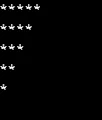
Exemple # 4
using System;
using System.Collections.Generic;
using System.Linq;
using System.Text;
namespace StarPattern
(
class Program
(
static void Main(string() args)
(
int x, y, z;
for (x = 5; x >= 1; x--)
(
for (y = 5; y > x; y--)
(
Console.Write(" ");
)
for (z = 1; z <=x; z++)
(
Console.Write("*");
)
Console.WriteLine();
)
Console.ReadLine();
)
)
)
Production:
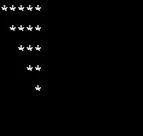
Exemple # 5
using System;
using System.Collections.Generic;
using System.Linq;
using System.Text;
namespace StarPattern
(
class Program
(
static void Main(string() args)
(
int x, y, z;
for (x= 1; x <= 5; x++)
(
for (y = x; y < 5; y++)
(
Console.Write(" ");
)
for (z = 1; z < (x * 2); z++)
(
Console.Write("*");
)
Console.WriteLine();
)
Console.ReadLine();
)
)
)
Production:

Exemple # 6
using System;
using System.Collections.Generic;
using System.Linq;
using System.Text;
namespace StarPattern
(
class Program
(
static void Main(string() args)
(
int x, y, z;
for (x = 5; x >= 1; x--)
(
for (y = 5; y > x; y--)
(
Console.Write(" ");
)
for (z = 1; z < (x * 2); z++)
(
Console.Write("*");
)
Console.WriteLine();
)
Console.ReadLine();
)
)
)
Production:
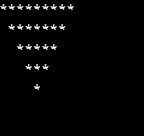
Exemple # 7
using System;
using System.Collections.Generic;
using System.Linq;
using System.Text;
namespace StarPattern
(
class Program
(
static void Main(string() args)
(
int x, y;
for (x = 1; x <= 5; x++)
(
for (y = x; y < 5; y++)
(
Console.Write(" ");
)
for (y = 1; y <= (2 * x - 1); y++)
(
if (x == 5 || y == 1 || y == (2 * x - 1))
(
Console.Write("*");
)
else
(
Console.Write(" ");
)
)
Console.WriteLine();
)
Console.ReadLine();
)
)
)
Production:
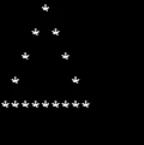
Exemple # 8
using System;
using System.Collections.Generic;
using System.Linq;
using System.Text;
namespace CharacterPattern
(
class Program
(
static void Main(string() args)
(
int x, y;
for (x = 1; x <= 5; x++)
(
for (y = 1; y <= 5; y++)
(
Console.Write("*");
)
Console.WriteLine();
)
Console.ReadLine();
)
)
)
Production:
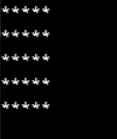
Exemple # 9
using System;
using System.Collections.Generic;
using System.Linq;
using System.Text;
namespace CharacterPattern
(
class Program
(
static void Main(string() args)
(
int x, y;
for (x = 1; x <= 5; x++)
(
for (y = 1; y <= x; y++)
(
if (y == 1 || y== x || x == 5)
(
Console.Write("*");
)
else
(
Console.Write(" ");
)
)
Console.WriteLine();
)
Console.ReadLine();
)
)
)
Production:
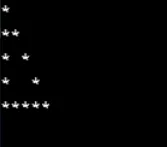
2. Modèles de nombres
Voici des exemples pour imprimer des modèles de nombres.
Exemple 1
using System;
using System.Collections.Generic;
using System.Linq;
using System.Text;
namespace NumberPattern
(
class Program
(
static void Main(string() args)
(
int x, y;
for (x = 1; x <= 5; x++)
(
for (y = 1; y <= x; y++)
(
Console.Write(y);
)
Console.WriteLine();
)
Console.ReadLine();
)
)
)
Production:

Exemple # 2
using System;
using System.Collections.Generic;
using System.Linq;
using System.Text;
namespace NumberPattern
(
class Program
(
static void Main(string() args)
(
int x, y;
for (x = 5; x >= 1; x--)
(
for (y = 1; y <= x; y++)
(
Console.Write(y);
)
Console.WriteLine();
)
Console.ReadLine();
)
)
)
Production:
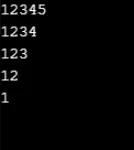
Exemple # 3
using System;
using System.Collections.Generic;
using System.Linq;
using System.Text;
namespace NumberPattern
(
class Program
(
static void Main(string() args)
(
int x, y;
for (x = 5; x >= 1; x--)
(
for (y = x; y <= 5; y++)
(
Console.Write(y);
)
Console.WriteLine();
)
Console.ReadLine();
)
)
)
Production:
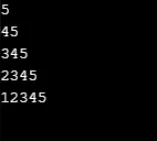
Exemple # 4
using System;
using System.Collections.Generic;
using System.Linq;
using System.Text;
namespace NumberPattern
(
class Program
(
static void Main(string() args)
(
int x, y;
for (x = 1; x <= 5; x++)
(
for (y = x; y <= 5; y++)
(
Console.Write(y);
)
Console.WriteLine();
)
Console.ReadLine();
)
)
)
Production:

Exemple # 5
using System;
using System.Collections.Generic;
using System.Linq;
using System.Text;
using System.Threading.Tasks;
namespace NumberPattern
(
class Program
(
static void Main(string() args)
(
int x, y;
for (x = 1; x <= 5; x++)
(
for (y = 1; y <= x; y++)
(
Console.Write(x);
)
Console.WriteLine();
)
Console.ReadLine();
)
)
)
Production:

Exemple # 6
using System;
using System.Collections.Generic;
using System.Linq;
using System.Text;
using System.Threading.Tasks;
namespace NumberPattern
(
class Program
(
static void Main(string() args)
(
int x, y;
for (x = 5; x >= 1; x--)
(
for (y = 5; y >= x; y--)
(
Console.Write(x);
)
Console.WriteLine();
)
Console.ReadLine();
)
)
)
Production:
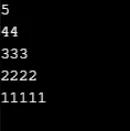
Exemple # 7
using System;
using System.Collections.Generic;
using System.Linq;
using System.Text;
using System.Threading.Tasks;
namespace NumberPattern
(
class Program
(
static void Main(string() args)
(
int x, y;
for (x = 5; x >= 1; x--)
(
for (y = 1; y <= x; y++)
(
Console.Write(x);
)
Console.WriteLine();
)
Console.ReadLine();
)
)
)
Production:
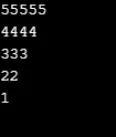
Exemple # 8
using System;
using System.Collections.Generic;
using System.Linq;
using System.Text;
using System.Threading.Tasks;
namespace NumberPattern
(
class Program
(
static void Main(string() args)
(
int x, y;
for (x = 1; x <= 5; x++)
(
for (y = 5; y >= x; y--)
(
Console.Write(x);
)
Console.WriteLine();
)
Console.ReadLine();
)
)
)
Production:
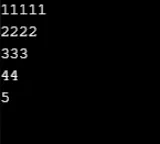
Exemple # 9
using System;
using System.Collections.Generic;
using System.Linq;
using System.Text;
using System.Threading.Tasks;
namespace NumberPattern
(
class Program
(
static void Main(string() args)
(
int x, y;
for (x = 6; x >= 1; x--)
(
for (y = x; y >= 1; y--)
(
Console.Write(y);
)
Console.WriteLine();
)
Console.ReadLine();
)
)
)
Production:
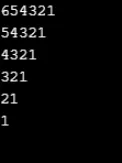
Exemple # 10
using System;
using System.Collections.Generic;
using System.Linq;
using System.Text;
using System.Threading.Tasks;
namespace NumberPattern
(
class Program
(
static void Main(string() args)
(
int x, y;
for (x = 1; x <= 5; x++)
(
for (y = 6; y >= x; y--)
(
Console.Write(y);
)
Console.WriteLine();
)
Console.ReadLine();
)
)
)
Production:
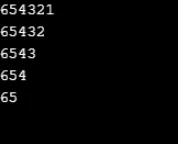
Exemple # 11
using System;
using System.Collections.Generic;
using System.Linq;
using System.Text;
using System.Threading.Tasks;
namespace NumberPattern
(
class Program
(
static void Main(string() args)
(
int x, y;
for (x = 7; x >= 1; x -= 2)
(
for (y = 1; y <= x; y++)
(
Console.Write(y);
)
Console.WriteLine();
)
Console.ReadLine();
)
)
)
Production:
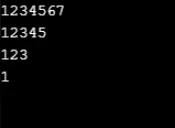
3. Motif de caractère
le Voici des exemples pour imprimer des motifs de caractères.
Exemple 1
using System;
using System.Collections.Generic;
using System.Linq;
using System.Text;
namespace CharacterPattern
(
class Program
(
static void Main(string() args)
(
int x, y;
int z = 5;
for (x = 1; x <= z; x++)
(
for (y = 1; y <= x; y++)
(
Console.Write((char)(x + 64));
)
Console.WriteLine("");
)
Console.ReadLine();
)
)
)
Production:
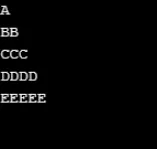
Exemple # 2
using System;
using System.Collections.Generic;
using System.Linq;
using System.Text;
namespace CharacterPattern
(
class Program
(
static void Main(string() args)
(
int x, y;
int z = 5;
for (x = 1; x <= z; x++)
(
for (y = x; y <= z; y++)
(
Console.Write((char)(x + 64));
)
Console.WriteLine("");
)
Console.ReadLine();
)
)
)
Production:
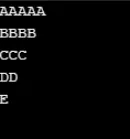
Exemple # 3
using System;
using System.Collections.Generic;
using System.Linq;
using System.Text;
namespace CharacterPattern
(
class Program
(
static void Main(string() args)
(
int x, y;
int z = 5;
for (x = 1; x <= z; x++)
(
for (y = 1; y <= x; y++)
(
Console.Write((char)(z - x + 1 + 64));
)
Console.WriteLine("");
)
Console.ReadLine();
)
)
)
Production:
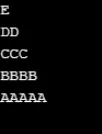
Exemple # 4
using System;
using System.Collections.Generic;
using System.Linq;
using System.Text;
namespace CharacterPattern
(
class Program
(
static void Main(string() args)
(
int x, y;
int z = 5;
for (x = 1; x <= z; x++)
(
for (y = x; y<= z; y++)
(
Console.Write((char)(y + 64));
)
Console.WriteLine();
)
Console.ReadLine();
)
)
)
Production:
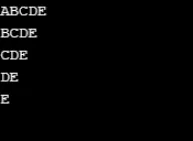
Exemple # 5
using System;
using System.Collections.Generic;
using System.Linq;
using System.Text;
namespace CharacterPattern
(
class Program
(
static void Main(string() args)
(
int x, y, z;
int k = 5;
for (x = 1; x <= k; x++)
(
for (y = 1; y <= k - x; y++)
(
Console.Write(" ");
)
for (z = 1; z <= x; z++)
(
Console.Write((char)(x + 64));
)
Console.WriteLine();
)
Console.ReadLine();
)
)
)
Production:
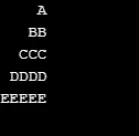
Exemple # 6
using System;
using System.Collections.Generic;
using System.Linq;
using System.Text;
namespace CharacterPattern
(
class Program
(
static void Main(string() args)
(
int x, y;
int a = 5;
for (x = 1; x <= a; x++)
(
for (y = x; y >= 1; y--)
(
Console.Write((char)(y + 64));
)
Console.WriteLine("");
)
Console.ReadLine();
)
)
)
Production:
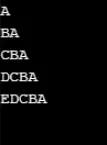
Exemple # 7
using System;
using System.Collections.Generic;
using System.Linq;
using System.Text;
namespace CharacterPattern
(
class Program
(
static void Main(string() args)
(
int x, y;
int a = 5;
for (x = a; x >= 1; x--)
(
for (y = a; y >= x; y--)
(
Console.Write((char)(y + 64));
)
Console.WriteLine("");
)
Console.ReadLine();
)
)
)
Production:
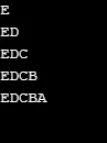
Exemple # 8
using System;
using System.Collections.Generic;
using System.Linq;
using System.Text;
namespace CharacterPattern
(
class Program
(
static void Main(string() args)
(
int x, y;
int a = 5;
for (x = 1; x <= a; x++)
(
for (y = a; y >= x; y--)
(
Console.Write((char)(y + 64));
)
Console.WriteLine("");
)
Console.ReadLine();
)
)
)
Production:
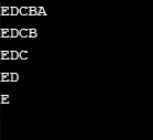
Exemple # 9
using System;
using System.Collections.Generic;
using System.Linq;
using System.Text;
namespace CharacterPattern
(
class Program
(
static void Main(string() args)
(
int x, y;
int z = 5;
for (x = z; x >= 1; x--)
(
for (y = x; y >= 1; y--)
(
Console.Write((char)(y + 64));
)
Console.WriteLine("");
)
Console.ReadLine();
)
)
)
Production:
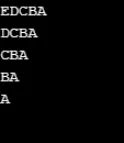
Exemple # 10
using System;
using System.Collections.Generic;
using System.Linq;
using System.Text;
namespace CharacterPattern
(
class Program
(
static void Main(string() args)
(
int x, y;
int z = 6;
for (x = 1; x <= z; x++)
(
for (y = 1; y<= z - x; y++)
(
Console.Write(" ");
)
for (y = 1; y <= x; y++)
(
Console.Write((char)(y + 64));
)
for (y = x - 1; y >= 1; y--)
(
Console.Write((char)(y + 64));
)
Console.WriteLine();
)
Console.ReadLine();
)
)
)
Production:
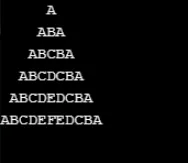
Conclusion
Donc ci-dessus sont quelques exemples de différents types de modèles. Nous pouvons imprimer n'importe quel type de motif avec quelques changements dans les boucles.
Articles recommandés
Ceci est un guide des modèles en C #. Nous discutons ici de l'introduction et des 3 principaux types de modèles en C # ainsi que de ses exemples et de l'implémentation du code. Vous pouvez également consulter les articles suivants pour en savoir plus-
- Qu'est-ce que Design Pattern en C #?
- Questions d'entretiens chez C # Design Pattern
- Tableaux 2D en C #
- Remplacement en C #
- Surcharge en Java
- 3 différents types de tableaux en PHP (exemples)
- Modèles de nombres en Java avec des exemples